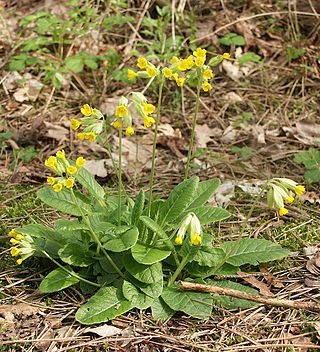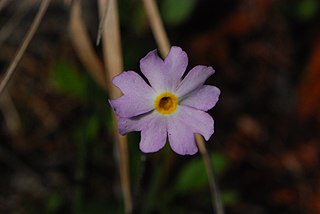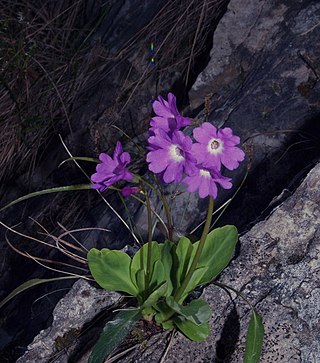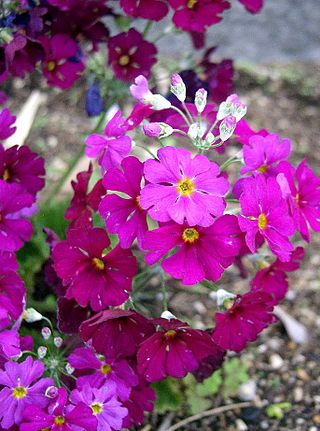
Primula is a genus of herbaceous flowering plants in the family Primulaceae. They include the primrose, a familiar wildflower of banks and verges. Other common species are P. auricula (auricula), P. veris (cowslip), and P. elatior (oxlip). These species and many others are valued for their ornamental flowers. They have been extensively cultivated and hybridised. Primula are native to the temperate Northern Hemisphere, south into tropical mountains in Ethiopia, Indonesia, and New Guinea, and in temperate southern South America. Almost half of the known species are from the Himalayas.

The Primulaceae, commonly known as the primrose family, are a family of herbaceous and woody flowering plants including some favourite garden plants and wildflowers. Most are perennial though some species, such as scarlet pimpernel, are annuals.

Primula veris, the cowslip, common cowslip, or cowslip primrose, is a herbaceous perennial flowering plant in the primrose family Primulaceae. The species is native throughout most of temperate Europe and western Asia, and although absent from more northerly areas including much of northwest Scotland, it reappears in northernmost Sutherland and Orkney and in Scandinavia. This species frequently hybridizes with other Primulas such as the common primrose Primula vulgaris to form false oxlip which is often confused with true oxlip, a much rarer plant.

Primula bulleyana is a species of flowering plant in the family Primulaceae, native to hillsides in China.

Primula vulgaris, the common primrose, is a species of flowering plant in the family Primulaceae, native to Eurasia. The common name is primrose, or occasionally common primrose or English primrose to distinguish it from other Primula species referred to as primroses.

Primula scotica, commonly known as Scottish primrose, is a species of flowering plant in the family, Primulaceae, the primroses and their relatives. It was first described by James Smith, and is endemic to the north coast of Scotland.

Primula sieboldii, the Japanese primrose, is a species of primrose that is endemic to East Asia. The species goes by common names such as Siebold's primrose, cherry blossom primrose, Japanese woodland primroseSnowflake, Geisha girl, Madam butterfly and the Japanese primrose which also applies to the related species Primula japonica.

Primula sinensis, or the Chinese primrose, is a plant species in the genus Primula.

Primula cusickiana is a species of flowering plant in the primrose family known by the common name Cusick's primrose. It is native to the western United States in and around the Great Basin. Its distribution extends into Oregon, Idaho, Nevada, and Utah.

Primula pulverulenta, the mealy primrose or mealy cowslip, is a species of flowering plant in the family Primulaceae. It is native to damp habitats in China. It is a herbaceous perennial growing to 100 cm (39 in) tall by 60 cm (24 in) broad, with strong stems of deep pink flowers arising from basal rosettes of leaves in early summer. The flowers are grouped at intervals along the stem in a tiered formation, hence the common name "candelabra primula" which is often applied to this and other species with a similar arrangement.

Primula poissonii, Poisson's primrose, is a species of flowering plant in the primrose family Primulaceae, native to wet areas at altitudes of 2,500–3,100 m (8,200–10,200 ft) in western Sichuan and central and northern Yunnan, China.

Primula prolifera, the candelabra primrose or glory of the bog, is a flowering plant in the family Primulaceae. Its botanical name is currently unresolved.

Primula mistassinica, also known as Mistassini primrose, Lake Mistassini primrose or bird's-eye primrose, is a flowering herb of the genus Primula. The specific name refers to Lake Mistassini in Quebec, Canada. It is native to the northeastern United States and much of Canada.

Alfred Ernst was a Swiss botanist.

Primula carniolica is a flowering plant in the primrose family known by the common name Carniolan primrose. It is endemic to Slovenia.

Primula malacoides, called the fairy primrose or baby primrose, is a perennial species of Primula native to the Himalayas, Assam in India, Myanmar, and south-central and south east China. It has gained the Royal Horticultural Society's Award of Garden Merit.

Primula secundiflora, the second-flowered primrose, is a species of flowering plant in the family Primulaceae, native to western China ., where it inhabits wet places at 3,200–4,800 m (10,500–15,700 ft). It belongs to the Candelabra group of primulas. Growing to 80 cm (31 in) tall, it is a semi-evergreen perennial bearing clusters of nodding deep red flowers at the top of erect stems.

Primula stricta, also known as the strict primrose, is a species of flowering plant in the family Primulaceae.

Primula × polyantha, the polyanthus primrose or false oxlip, is a naturally occurring hybrid species of flowering plant in the family Primulaceae. It is the result of crosses between Primula veris and Primula vulgaris. It is native to Europe, found where the parent species' ranges overlap, and many artificial hybrid cultivars have also been created for the garden trade. Naturally‑occurring individuals tend to have yellow flowers, while a wide range of flower colors has been developed in the cultivars over the centuries.


















